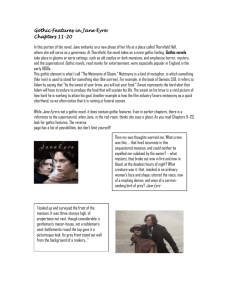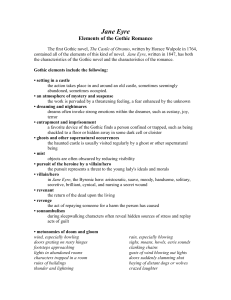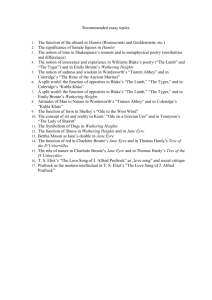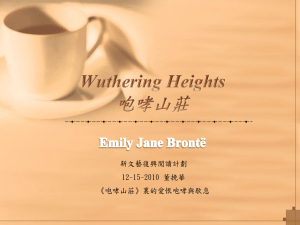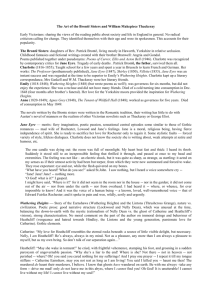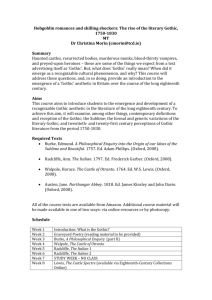EL 489.01: Women and the Gothic
advertisement
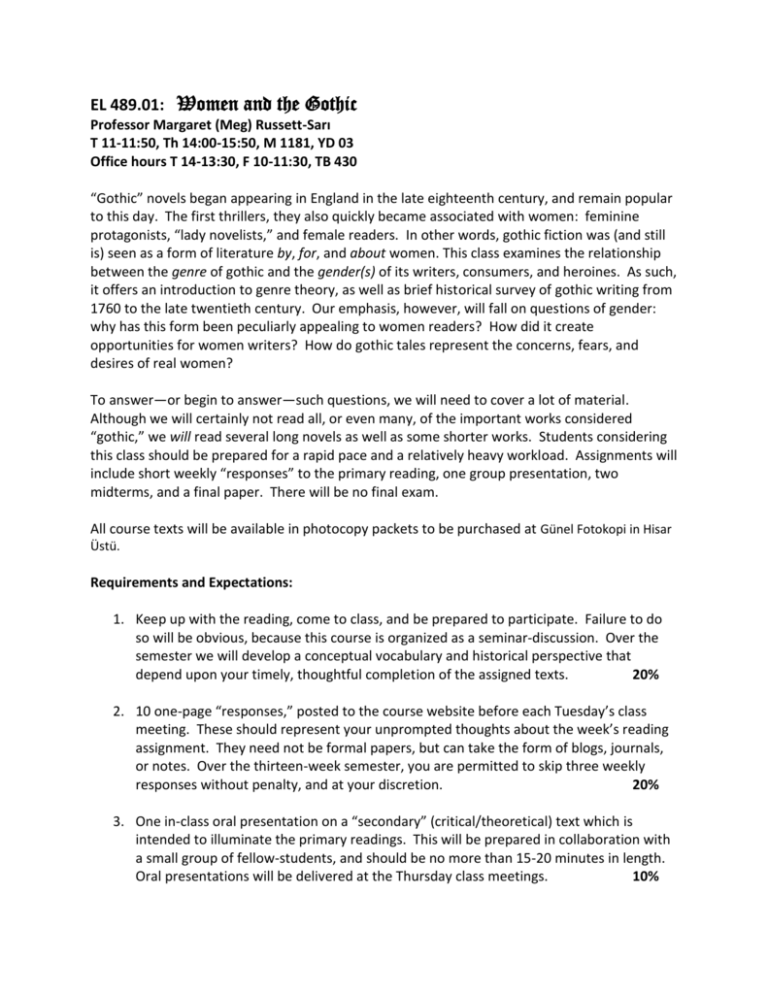
EL 489.01: Women and the Gothic Professor Margaret (Meg) Russett-Sarı T 11-11:50, Th 14:00-15:50, M 1181, YD 03 Office hours T 14-13:30, F 10-11:30, TB 430 “Gothic” novels began appearing in England in the late eighteenth century, and remain popular to this day. The first thrillers, they also quickly became associated with women: feminine protagonists, “lady novelists,” and female readers. In other words, gothic fiction was (and still is) seen as a form of literature by, for, and about women. This class examines the relationship between the genre of gothic and the gender(s) of its writers, consumers, and heroines. As such, it offers an introduction to genre theory, as well as brief historical survey of gothic writing from 1760 to the late twentieth century. Our emphasis, however, will fall on questions of gender: why has this form been peculiarly appealing to women readers? How did it create opportunities for women writers? How do gothic tales represent the concerns, fears, and desires of real women? To answer—or begin to answer—such questions, we will need to cover a lot of material. Although we will certainly not read all, or even many, of the important works considered “gothic,” we will read several long novels as well as some shorter works. Students considering this class should be prepared for a rapid pace and a relatively heavy workload. Assignments will include short weekly “responses” to the primary reading, one group presentation, two midterms, and a final paper. There will be no final exam. All course texts will be available in photocopy packets to be purchased at Günel Fotokopi in Hisar Üstü. Requirements and Expectations: 1. Keep up with the reading, come to class, and be prepared to participate. Failure to do so will be obvious, because this course is organized as a seminar-discussion. Over the semester we will develop a conceptual vocabulary and historical perspective that depend upon your timely, thoughtful completion of the assigned texts. 20% 2. 10 one-page “responses,” posted to the course website before each Tuesday’s class meeting. These should represent your unprompted thoughts about the week’s reading assignment. They need not be formal papers, but can take the form of blogs, journals, or notes. Over the thirteen-week semester, you are permitted to skip three weekly responses without penalty, and at your discretion. 20% 3. One in-class oral presentation on a “secondary” (critical/theoretical) text which is intended to illuminate the primary readings. This will be prepared in collaboration with a small group of fellow-students, and should be no more than 15-20 minutes in length. Oral presentations will be delivered at the Thursday class meetings. 10% 4. Two short, “objective” (multiple-choice and short-answer) midterm exams, taken during class time on the dates listed below. 20% 5. One 7-10 page term paper, on a topic of your own choice, due on the date of the final exam. Proposals for the final paper must be submitted at least two weeks before the last class meeting. 30% Schedule: T 29/9 Introduction Th 1/10 Angela Carter, “The Bloody Chamber” T 6/10 Horace Walpole, The Castle of Otranto Th 8/10 The Castle of Otranto, continue T 13/10 Ann Radcliffe, The Mysteries of Udolpho (selections) Th 15/10 The Mysteries of Udolpho, continue T 20/10 Jane Austen, Northanger Abbey Th 22/10 Northanger Abbey, continue T 27/10 Samuel Taylor Coleridge, “Christabel” (narrative poem) Th 29/10 Cumhuriyet Bayramı: no class meeting T 3/11 Charlotte Bronte, Jane Eyre (begin) Th 5/11 Jane Eyre, continue T 10/11 Jane Eyre, continue Th 12/11 Jane Eyre, conclude FIRST MIDTERM T 17/11 Emily Bronte, Wuthering Heights (begin) Th 19/11 Wuthering Heights, continue T 24/11 Wuthering Heights, continue Th 26/11 Wuthering Heights, conclude T 1/12 Daphne Du Maurier, Rebecca (begin) Th 3/12 Rebecca, continue T 8/12 Rebecca, continue Th 10/12 Rebecca, conclude PROPOSALS FOR FINAL PAPERS DUE T 15/12 Barbara Vine, The House of Stairs (begin) Th 17/12 The House of Stairs, continue T 22/12 The House of Stairs, conclude SECOND MIDTERM Th 24/12 Conclusion


